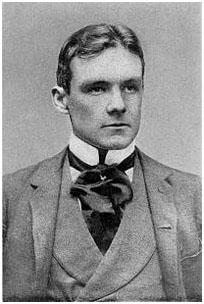

Richard Harding Davis (April 18, 1864 – April 11, 1916) was a journalist and writer of fiction and drama, known foremost as the first American war correspondent to cover the Spanish-American War, the Second Boer War, and the First World War. His writing greatly assisted the political career of Theodore Roosevelt and he also played a major role in the evolution of the American magazine. His influence extended to the world of fashion and he is credited with making the clean-shaven look popular among men at the turn of the 20th century.
Davis was born on April 18, 1864 in Philadelphia, Pennsylvania. His mother Rebecca Harding Davis was a prominent writer in her day. His father, Lemuel Clarke Davis, was himself a journalist and edited the Philadelphia Public Ledger.He attended the Episcopal Academy, and then later Lehigh University and Johns Hopkins University. While at Lehigh, he is credited with establishing the Lehigh Football team and the resulting Lehigh-Lafayette Football Rivalry. He was asked to leave both Lehigh University and Johns Hopkins University for neglecting his studies in favor of his social life.
His father found him his first position as a journalist at the Philadelphia Record but he was soon dismissed. After another brief position at the Philadelphia Press, he accepted a better-paying position at the New York Evening Sun where he gained attention for his flamboyant style and his writing on controversial subjects such as abortion, suicide and execution. He first attracted attention in May to June 1889, by reporting on the devastation of Johnstown, Pennsylvania, following the infamous flood and added to his reputation by reporting on other noteworthy events such as the first electrocution of a criminal (the execution of William Kemmler in 1890).
Davis became a managing editor of Harper's Weekly, and was one of the world's leading war correspondents at the time of the Second Boer War in South Africa. As an American, he had the opportunity to see the war first-hand from both the British and Boer perspectives. Davis also worked as a reporter for the New York Herald, The Times, and Scribner's Magazine.
He was popular among a number of leading writers of his time, and is considered the model for illustrator Charles Dana Gibson's dashing Gibson man, the male equivalent of his famous Gibson Girl. He is also mentioned early in Sinclair Lewis's book Dodsworth as the example of an exciting, adventure-seeking legitimate hero.
During the Spanish-American War, Davis was on a United States Navy warship when he witnessed the shelling of Matanzas, Cuba, a part of the Battle of Santiago de Cuba. Davis' story made headlines, but as a result, the Navy prohibited reporters from being aboard any American naval vessel for the rest of the war.
Davis was a good friend of Theodore Roosevelt, and he helped create the legend surrounding the Rough Riders, for which he was made an honorary member. Some[who?] have even gone so far to accuse Davis of involvement in William Randolph Hearst's alleged plot to have started the war between Spain and the United States in order to boost newspaper sales; however, Davis refused to work for Hearst after a dispute over fictionalizing one of his articles.
Despite his alleged association with Yellow journalism, his writings of life and travel in Central America, the Caribbean, Rhodesia and South Africa during the Second Boer War were widely published. He was one of many war correspondents who covered the Russo-Japanese War from the perspective of the Japanese forces.
Davis had success with his 1897 novel Soldiers of Fortune that he turned into a play and was later filmed twice, once in 1914 and in 1919 by Allan Dwan.
Davis later reported on the Salonika Front of the First World War where he was arrested by the Germans as a spy but was released.
Davis was married twice, first to Cecil Clark, an artist, in 1899, and then to Bessie McCoy in 1912, an actress and Vaudeville performer, who is remembered for her signature Yama Yama Man routine. Davis and Bessie had a daughter, Hope.
He died of a heart attack on April 11, 1916, seven days before his 52nd birthday.



















